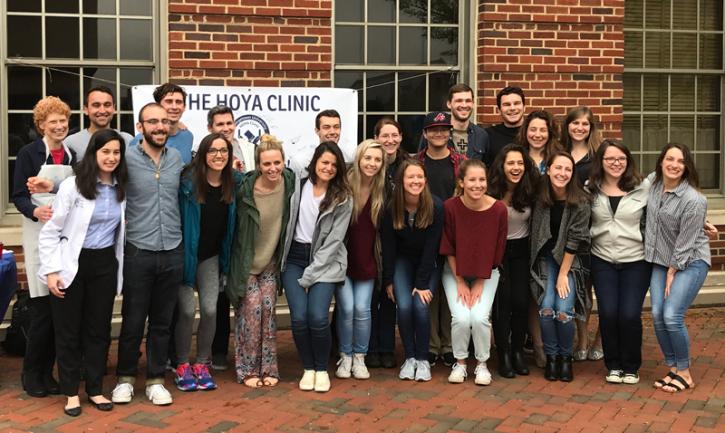Students Reflect on Experiences at the HOYA Clinic

Posted in GUMC Stories | Tagged HOYA Clinic, population health
(May 11, 2018) — When she applied to medical schools, Cassandra Presti (M’18) was looking for an institution that was dedicated to serving underserved populations. “During my interview with Dean Mitchell, I asked him what the students at Georgetown were like,” she said. “He told me that if I wanted to know anything about the students at Georgetown, I should look no further than HOYA Clinic.”
Since January 2008, hundreds of Georgetown University School of Medicine students have volunteered at the Health Outreach for Youth and Adults (HOYA) Clinic, a student-driven free clinic in the D.C. General Family Shelter, located in southeast Washington, D.C. While organized and run by Georgetown medical students, volunteer physicians train the students as they interact with patients at the clinic, which is a collaborative program of MedStar Georgetown Division of Community Pediatrics and Georgetown University School of Medicine.
Volunteering at the clinic, which strives to provide quality health care to underserved populations in D.C. in the spirit of cura personalis, or care of the whole person, has had a profound impact on the lives of many students, including several members of the Class of 2018.
Student-Run, Patient-Focused
While pre-clinical medical students rarely interact with patients, “the HOYA Clinic is totally run by first- and second-year students,” said Jack Penner (M’18). “It totally flips the traditional model of medical care on its head. You’re the primary contact with the patient and everyone else is there to give you backup if you get stuck.”
Being able to volunteer at the HOYA Clinic was one of the reasons that Amanda Cain (M’18) chose Georgetown for medical school. “Not every medical school has something like this where the students really run the clinic,” she said.
Having the opportunity to build connections with patients made volunteering at the HOYA Clinic a rewarding experience, Penner said. “They’re so open and they’re so welcoming to students,” he said. “Our ability to be involved really feels like a privilege and that’s set by the patients who are so warm.”
Cain was motivated to keep volunteering at the HOYA Clinic by the patients. “I felt like these were my patients and my community, and I didn’t want to stop being a part of that,” she said.
“I’ll Never Forget That Moment”
The clinic’s student-run nature encourages volunteers to develop different ways to help patients. Students lead HPV education workshops, conduct screenings for developmental delays in children, teach exercise classes and organize a summer camp for children, the HOYAMed Summer Sports Camp.
“You really have an opportunity to start things,” Penner said. “They give us so many chances to do things that I don’t think you really get at other medical schools.”
George Koch (M’18) volunteered with the sports camp the summer before he started at the School of Medicine. “After my first day, I knew I wanted to continue to be heavily involved in HOYA,” he said. Over the course of his first semester at the School of Medicine, Koch helped organize a monthly activity day called Big HOYA Little Saxa “to connect the children at D.C. General with consistent mentorship and role models,” he said.
“Two months ago, while walking into HOYA Clinic for my last shift of medical school, I was approached by a young man who was at our first activity day,” Koch added. “He was very proud to tell me that he was recently offered three full scholarships to four-year colleges, and that he will be going to school for business starting next year. I’ll never forget that moment.”
Cain and Penner worked together to organize the Maternal Health Team at the HOYA Clinic to improve prenatal care for D.C. General residents. In addition to sharing information, the Maternal Health Team hosts a support group for pregnant women and mothers. “Sometimes being homeless, you don’t really have people to turn to,” Cain said. “It felt really special to sit in on this group, they were giving each other advice.”
While initially interested in neurosurgery, Cain’s experiences at the HOYA Clinic inspired her to pursue a career in OB-GYN. “I loved working with that population,” she said. “I loved working with women, with that age group, and trying to give these children the best start possible starts with prenatal care.”
A Critical Part of Medical Education
Before applying to serve as a HOYA Clinic coordinator, Cain spoke with other coordinators about how making a commitment to the clinic had impacted their education. “It only enhanced their medical experience,” she said.
Penner learned about the importance of teamwork and humility at the HOYA Clinic. “It instilled in me this appreciation of how much I don’t know,” he said. “Despite how much I may learn, there are so many things I will never know because of the firsthand experiences that I haven’t had.”
The patients at the HOYA Clinic showed Presti how social determinants of health can impact a patient’s life. “They taught me the importance of being a physician-advocate and a physician-healer, in addition to the physician-scientist we learn about in the classroom,” she said.
“Volunteering at HOYA Clinic was one of the highlights of my medical school experience,” Presti said. “While at DC General, I was constantly reminded of why I chose to become a physician.”
Kat Zambon
GUMC Communications
